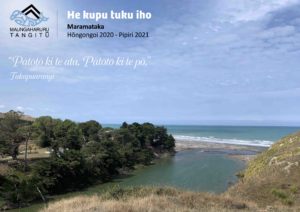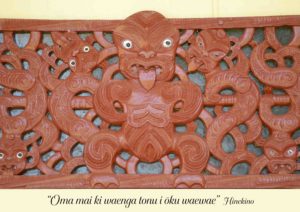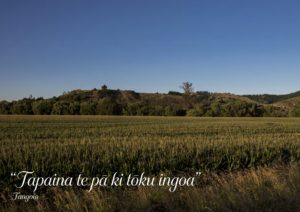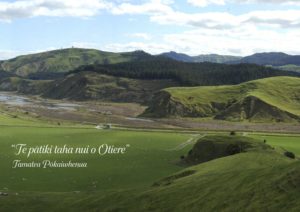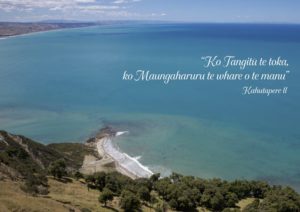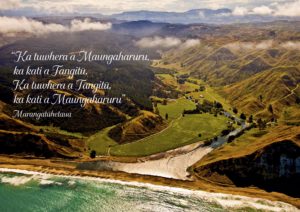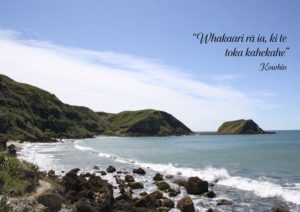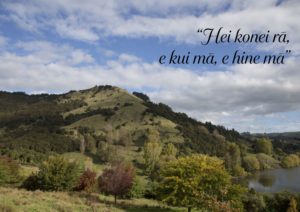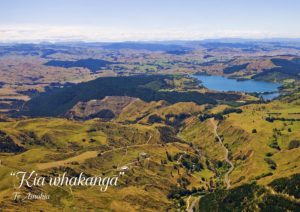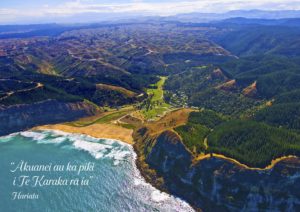This maramataka includes kōrero about our tīpuna and their quotes. The purpose of this webpage is to expand on that kōrero by providing further reading.
Hinekino
More detailed kōrero about Hinekino the tohunga can be found in the book Tūtira by Guthrie-Smith. See the last section of page 65 of this online version.
Tukapuarangi, Waikare
The links below are to more of our Hapū kōrero about Tukapuarangi, Ngāi Tahu, the Waikare area and the Waikari river:
- Ngāi Tahu webpage
- Te Kuta Reserve (Statement of Association from our Deed of Settlement)
- Waikari River (Statement of Association from our Deed of Settlement)
You can visit Waikare, there is a DOC campground and walking access to the beach.
Tangoio, Te Rae-o-Tangoio
Tangoio is carved on our whare tīpuna, Punanga-te-Wao. He is the amo on the right (when you are looking at the whare). Click here to read more about him and the Tangoio area in the Statement of Association from our Deed of Settlement.
You can see Te Rae-o-Tangoio from Tangoio Beach. If you would like more information on visiting Tangoio Falls Reserve, click here.

Tamatea Pōkaiwhenua, Otiere
A Harbour Lost is an article written by Pat Parsons. It includes all the words to Tamatea Pōkaiwhenua’s pepeha and lots of history about Te Whanganui-ā-Orotu, including a map and images. You can download it here.
Tātaramoa was born at Otiere. You can read more about him and Ngāi Tatara here.
You can visit Otiere and Roro-o-kurī, there is a walking track around it. Click here for more information from Te Papa Atawhai (DOC).
Kautapere II, Tātaramoa, Moeangiangi
You can read more about Kahutapere II’s son Tātaramoa and Ngāi Tatara here.
For more about Tātaramoa and Moeangiangi, see these Statements of Association from our Deed of Settlement:
Kohipipi, Te Pā-o-Toi
The great warrior Kohipipi is carved on our whare tīpuna, Punanga-te-Wao. He is in the māhau, first on the left. His daughter Te Ahimatutunu is carved below him.
You can read about Te Pā-o-Toi and Tangoio in our Deed of Settlement here.
Unfortunately Tangoio Falls Reserve is closed from November 2020 to May 2021, click here for information from Te Papa Atawhai (DOC).
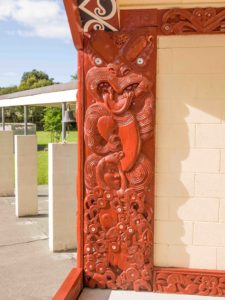
Marangatūhetaua & Te Ruruku, Arapawanui
You can read more about Marangatūhetaua here,
and Te Ruruku by clicking here.
For more history about Arapawanui, see this Statement of Association from our Deed of Settlement.
Marangatūhetaua & Te Ruruku, Tangoio
You can read more about Marangatūhetaua here,
and Te Ruruku by clicking here.
For more history about the tuna in Te Ngarue at Tangoio, see this Statement of Association from our Deed of Settlement.
Te Wharangi, Waipātiki
For more history about Te Wharangi pā and Waipātiki, see this Statement of Association from our Deed of Settlement.
Kowhio, Whakaari
You can see the kupu (lyrics) to ‘Te Waiata nā Kowhio’, and translation by Kaumātua Fred Reti here.
For more history about Whakaari, see this Statement of Association from our Deed of Settlement.
Ngāi Tātara, Te Puku
The book Tutira by Guthrie-Smith has an account of the event described in the Maramataka. See pages 73 of this online version.
For more history about Tūtira, see this Statement of Association from our Deed of Settlement.
Te Amohia
Te Amohia was a wahine of Ngāi Tātara, the Maramataka describes how her and her aunties were captured then escaped. There are interesting details about their escape in the book Tutira by Guthrie-Smith. See pages 74 of this online version.
For more history about Tūtira, see this Statement of Association from our Deed of Settlement.
Hariata
Hariata was a wahine in love with Te Iwi Whati. Kowhio composed a waiata for her. For the words to the waiata, and some more background info click the links below:


